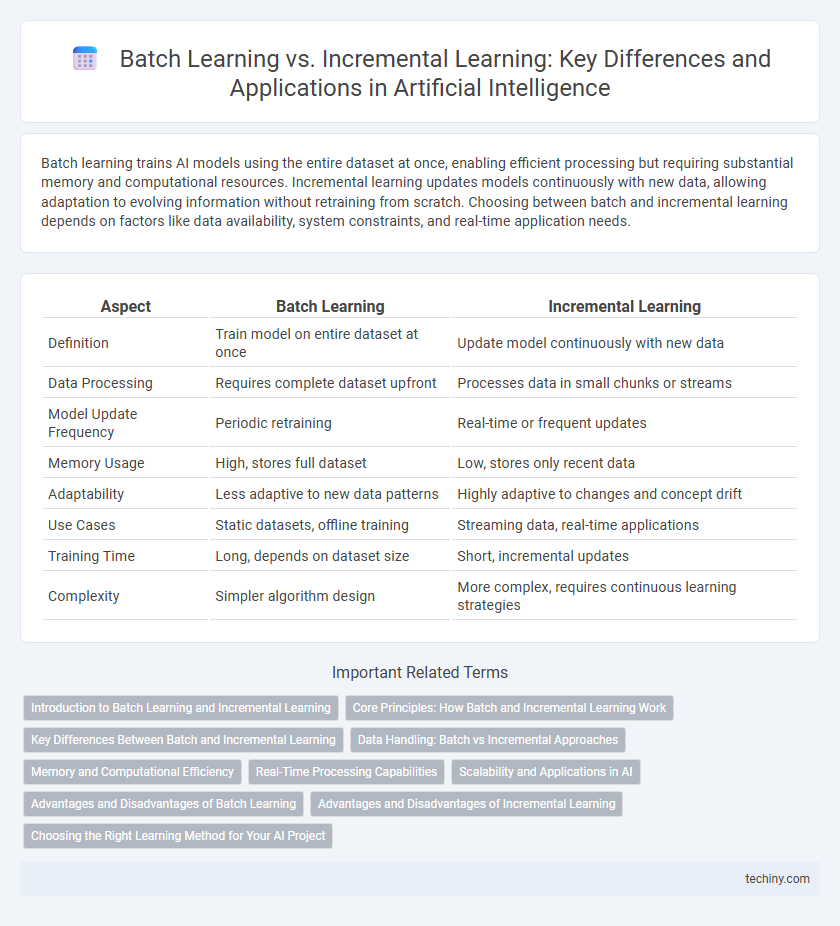Batch learning trains AI models using the entire dataset at once, enabling efficient processing but requiring substantial memory and computational resources. Incremental learning updates models continuously with new data, allowing adaptation to evolving information without retraining from scratch. Choosing between batch and incremental learning depends on factors like data availability, system constraints, and real-time application needs.
Table of Comparison
| Aspect | Batch Learning | Incremental Learning |
|---|---|---|
| Definition | Train model on entire dataset at once | Update model continuously with new data |
| Data Processing | Requires complete dataset upfront | Processes data in small chunks or streams |
| Model Update Frequency | Periodic retraining | Real-time or frequent updates |
| Memory Usage | High, stores full dataset | Low, stores only recent data |
| Adaptability | Less adaptive to new data patterns | Highly adaptive to changes and concept drift |
| Use Cases | Static datasets, offline training | Streaming data, real-time applications |
| Training Time | Long, depends on dataset size | Short, incremental updates |
| Complexity | Simpler algorithm design | More complex, requires continuous learning strategies |
Introduction to Batch Learning and Incremental Learning
Batch learning processes the entire dataset at once, enabling models to learn from fixed, large volumes of data but requiring significant computational resources and time. Incremental learning updates models continuously as new data arrives, allowing for adaptability and efficiency in dynamic environments with streaming data. These contrasting approaches cater to different AI applications, with batch learning suited for static datasets and incremental learning ideal for real-time, evolving data scenarios.
Core Principles: How Batch and Incremental Learning Work
Batch learning trains AI models using the entire dataset at once, optimizing performance through multiple passes over fixed data, which allows for thorough pattern extraction but requires substantial memory and processing time. Incremental learning processes data sequentially, updating models continuously with new data points, enabling adaptation to changing environments and real-time learning without retraining from scratch. The core difference lies in batch learning's reliance on static datasets versus incremental learning's dynamic model updates, balancing the trade-offs between computational efficiency and responsiveness.
Key Differences Between Batch and Incremental Learning
Batch learning processes the entire dataset at once, requiring substantial computational resources and memory, which makes it suitable for static datasets with infrequent updates. Incremental learning updates the model continuously or in small data chunks, enabling real-time adaptation to new data while minimizing memory usage. Key differences include data processing methods, model update frequency, and computational efficiency, with batch learning favoring accuracy on fixed datasets and incremental learning prioritizing adaptability in dynamic environments.
Data Handling: Batch vs Incremental Approaches
Batch learning processes the entire dataset at once, enabling thorough analysis and model training with consistent data. Incremental learning updates models continuously by incorporating new data in small chunks, allowing real-time adaptation without retraining on the complete dataset. This distinction in data handling drives efficiency differences, with batch learning excelling in static environments and incremental learning suited for dynamic, evolving data streams.
Memory and Computational Efficiency
Batch learning processes large datasets all at once, requiring significant memory and computational resources, making it less efficient for continuous data updates. Incremental learning updates models with new data incrementally, optimizing memory usage and reducing computational overhead by avoiding retraining from scratch. This approach enhances scalability and real-time adaptability in AI systems handling streaming or evolving data.
Real-Time Processing Capabilities
Batch learning processes large datasets at once, making it efficient for static data but unsuitable for real-time applications due to high latency. Incremental learning updates models continuously with new data, enabling rapid adaptation and real-time decision-making in dynamic environments. This capacity for continuous learning makes incremental learning essential for applications requiring timely responses, such as autonomous systems and real-time analytics.
Scalability and Applications in AI
Batch learning processes entire datasets at once, making it less scalable for large or continuously growing data but highly effective in scenarios where data is static, such as image recognition with fixed datasets. Incremental learning updates models with new data in real-time or mini-batches, enhancing scalability for applications like online recommendation systems and autonomous vehicles where data streams are continuous. This adaptability allows incremental learning to be crucial for dynamic AI environments requiring constant model evolution without full retraining.
Advantages and Disadvantages of Batch Learning
Batch learning processes the entire dataset at once, enabling the model to learn from comprehensive, static data, which often results in higher accuracy and stability. However, it requires significant computational resources and time, making it less suitable for real-time or rapidly changing data environments. Its inability to update the model incrementally limits adaptability to new data without retraining from scratch.
Advantages and Disadvantages of Incremental Learning
Incremental learning allows AI models to update continuously with new data, enhancing adaptability and reducing the need for complete retraining, which saves computational resources. This approach excels in dynamic environments where data evolves rapidly, but it risks accumulating errors and concept drift if not properly managed. Unlike batch learning, incremental learning can face challenges in maintaining model stability and ensuring consistent performance as it integrates incremental updates over time.
Choosing the Right Learning Method for Your AI Project
Choosing between batch learning and incremental learning depends on the nature of your dataset and computational resources. Batch learning processes the entire dataset at once, ideal for static data and achieving high accuracy, while incremental learning updates the model continuously with new data, suiting dynamic environments and real-time applications. Evaluating factors such as data volume, model complexity, and latency requirements ensures the selected learning method aligns with your AI project's goals.
Batch Learning vs Incremental Learning Infographic

 techiny.com
techiny.com